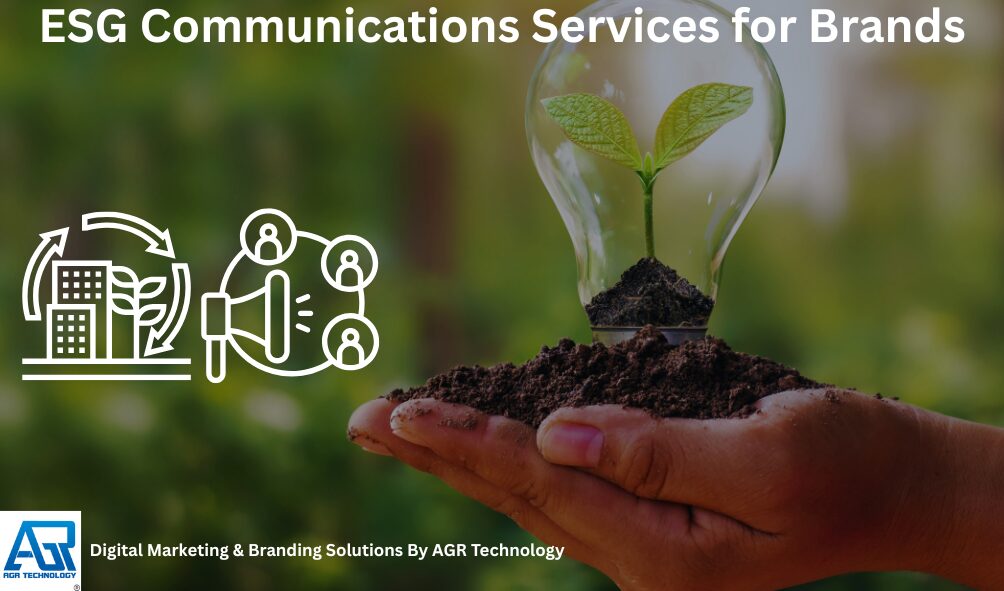Sustainability isn’t just a buzzword—it’s a business imperative. As Environmental Social Governance (ESG) concerns reshape the marketplace, brands face growing pressure from customers, investors and communities to prove their commitment to a better world. In fact, ESG performance now plays a significant role in investment decisions and brand loyalty, making transparent communication more crucial than ever.
We know that navigating ESG communications can feel complex, but it’s the bridge that connects a brand’s sustainability efforts with its public image. By sharing authentic stories and clear data, companies can build trust, foster engagement and strengthen their reputation. As expectations rise, brands that integrate ESG communications into their core strategy stand out—showing not just what they do, but why it matters.
Book a free consultation call with AGR Technology to see how we can help scale your brand with proven online marketing strategies
Reviews from some of our happy customers:
Supporting businesses of all sizes to get ahead with digital solutions






Why work with us?
Understanding ESG Communications for Brands

ESG communications help brands articulate their environmental, social, and governance commitments to stakeholders and the public. Effective messaging aligns ESG priorities with business strategy, making a brand’s commitments clear and accessible. Transparent, high-quality ESG communications demonstrate not only compliance but also a genuine sense of responsibility, which stakeholders have come to expect in today’s marketplace.
Medium-to-large enterprises consistently face scrutiny from investors, customers, and employees who monitor how ESG efforts translate into action and disclosure. Structured ESG communications provide a framework for regular updates on progress, highlight key initiatives, and offer stakeholders verifiable data—a necessity for companies operating in sectors where reputation and stakeholder trust directly impact valuation.
ESG communications strengthen a brand’s market position by:
- Showcasing Strategic Purpose: Communicate how ESG principles form the foundation of our operations and drive decisions across the business.
- Building Stakeholder Trust: Provide credible, ongoing ESG reporting and dialogue that fosters confidence among investors, customers, and partners.
- Supporting Investor Engagement: Disclose ESG risks and opportunities in language suited to investor needs, using consistent frameworks and data.
- Improving Corporate Image: Share measurable progress on climate action, diversity, and governance practices, reinforcing claims of ethical leadership.
Companies using integrated ESG communications influence audience perceptions by demonstrating their commitment to responsible growth and transparent reporting. Leveraging digital platforms and sustainability software, we can visualise complex ESG data, generating accessible content for a diverse audience. Digital-first communications also enhance reach and engagement, which are essential for enterprises with global or regionally distributed stakeholders.
A structured ESG narrative sets the tone for investor reports, CSR branding, and sustainability storytelling. Coupled with project identification and cause mapping, brands consistently reinforce their purpose and connect ESG programs to their geographic and operational footprint. This approach bolsters reputation, drives long-term loyalty, and improves access to ESG-focused capital—critical for sustained, responsible growth in competitive sectors.
Key Benefits of ESG Communications Services
Effective ESG communications services deliver measurable value for brands operating in complex, stakeholder-driven markets. Integrating ESG messaging into corporate strategy supports credibility, brand reputation, and long-term growth.
Building Trust and Transparency
Building trust and transparency starts with clear, consistent ESG disclosures that align with stakeholder expectations. ESG communications services enable brands to:
- Disclose accurate ESG data through investor reports, press releases, and public filings
- Create transparent sustainability updates for websites and annual reports
- Address both achievements and challenges to demonstrate authenticity
Publicly available, verifiable disclosures—such as carbon reduction plans or diversity metrics—remove ambiguity around ESG performance. As stakeholder scrutiny rises, regular updates foster genuine trust among investors, employees, and communities.
Enhancing Brand Reputation and Competitive Edge
Enhancing brand reputation and competitive edge involves proactive ESG storytelling and visibility across media channels. ESG communications services help brands:
- Position corporate sustainability as a central brand pillar using news coverage and ESG-focused media features
- Secure favorable mentions in sustainability publications, building credibility with potential customers and partners
- Differentiate from competitors by showcasing third-party benchmarks and recognitions
Brands that syndicate ESG success stories and explain their governance approach are better equipped to attract ESG-conscious clients, appeal to future employees, and stand out in procurement processes.
Strengthening Stakeholder Engagement
Strengthening stakeholder engagement relies on targeted ESG content and ongoing dialogue. ESG communications services support stakeholder engagement by:
- Facilitating community and investor forums to gather feedback and communicate progress
- Adapting ESG messages for different stakeholder groups through tailored reports and social media campaigns
- Inviting stakeholder participation in purpose-driven initiatives, such as environmental restoration or workplace inclusion programs
Strategic outreach—via sustainability updates, targeted social content, or community Q&As—keeps audiences informed and invested. Listening and responsiveness create a sense of shared purpose and long-term advocacy.
Core Components of Effective ESG Communications
Distinct, well-structured ESG communications anchor a brand’s sustainable reputation and stakeholder engagement. We create clarity and build measurable trust with a strategic approach to purpose, storytelling, compliance, and multi-channel distribution.
Defining Purpose and Strategy
Defining purpose and strategy grounds ESG communications in the brand’s mission and business objectives. We align sustainability messaging with core values, integrating ESG goals into business strategy for a cohesive narrative. Mapping stakeholder priorities and identifying specific geographic or material ESG focus areas—such as climate targets or diversity initiatives—ensures relevance for internal and external audiences.
Storytelling and Content Creation
Storytelling and content creation transform data and commitments into compelling, evidence-based narratives. We develop content that connects ESG actions and outcomes, using quantitative results and real stories—like emissions-reduction milestones or social impact projects. Visualisations, case studies, and personal spotlights support credibility, strengthening stakeholder belief in the brand’s ESG journey.
Compliance and Disclosure Management
Compliance and disclosure management ensure transparent, accurate ESG reporting that meets regulatory and stakeholder expectations. We manage consistent reporting cycles, emphasising frameworks such as GRI or SASB, and articulate clear sustainability performance, risk factors, and areas for improvement. Public ESG disclosures, such as impact reports and sustainability dashboards, showcase accountability and proactively minimise reputational risk.
Multi-Channel Communication Approaches
Multi-channel communication approaches expand ESG messaging across all relevant platforms, maximising visibility and engagement. We distribute targeted ESG content across digital, social, and traditional media—leveraging platforms such as LinkedIn, investor portals, and industry publications. Integrated digital strategies ensure regular updates reach investors, employees, and communities, while consistent messaging—tailored for each channel—supports real-time dialogue and enhances accessible stakeholder communication.
How ESG Communications Services Support Brands
Strategic ESG communications services empower brands to connect sustainability initiatives with stakeholder expectations. These services strengthen the alignment between internal culture and public perception while supporting ongoing engagement and risk management.
Internal Alignment and Employee Engagement
ESG communications services foster internal alignment by integrating sustainability values with a company’s culture and employee experience. Regular updates on ESG goals, policies, and progress ensure employees feel connected and motivated. Initiatives such as sustainability workshops, transparent forums, and real-time dashboards help employees understand how their roles contribute to ESG targets. When employees engage with authentic ESG narratives, retention rates and morale improve, and teams become brand ambassadors who reinforce purpose-led messaging in the marketplace.
Investor and Partner Relations
ESG communications services enhance investor and partner relations by delivering transparent, consistent information on ESG performance and strategy. Detailed annual impact reports, ongoing ESG disclosures, and tailored presentations provide vital data points for institutional investors and strategic partners. These communications address questions about governance, risk mitigation, and long-term value creation using clear metrics for environmental impact and social responsibility. Robust ESG updates can attract ESG-conscious investors and elevate a brand’s credibility during capital raising and partnership negotiations.
Crisis Management and Reputation Protection
ESG communications services improve crisis management and reputation protection by ensuring rapid, coordinated, and honest messaging when ESG risks or public scrutiny arise. Dedicated response protocols, pre-approved holding statements, and stakeholder-targeted updates enable brands to mitigate misinformation and maintain trust. Transparent communications—whether about environmental incidents, labour matters, or governance issues—show accountability and a commitment to continuous improvement. These services also support brand recovery by tracking sentiment, issuing clarifications, and highlighting corrective actions—preserving reputation and mitigating long-term brand damage.
Best Practices for ESG Communications
Effective ESG communications services for brands support credibility, transparency, and stakeholder confidence. Following best practices, we build lasting trust and drive measurable impact for enterprises navigating the evolving sustainability landscape.
Avoiding Greenwashing and Ensuring Authenticity
Authenticity in ESG communications prevents allegations of greenwashing and protects brand reputation. We publish clear, detailed ESG disclosures, verifying claims with audit-grade data, supporting statements with specific, recent performance metrics, and referencing independent benchmarks when available. Aligning our reported ESG actions with actual operational outcomes, then acknowledging areas for ongoing improvement, demonstrates accountability. For example, we communicate reductions in Scope 1, 2, and 3 emissions with comparative year-over-year data, rather than general statements. Engaging stakeholders with concise ESG updates, and inviting external feedback, allows us to reinforce commitment to genuine progress and respond accurately to market expectations.
Measuring Impact and Continuous Improvement
Continuous improvement in ESG communications requires ongoing measurement and transparent reporting of outcomes. We use robust metrics—such as energy usage, diversity ratios, supply chain audit results, and stakeholder engagement frequencies—to assess progress against stated ESG goals. Integrating these metrics into structured reports and visual dashboards enables stakeholders to track results in real time. Quarterly or annual reviews publish changes since the previous reporting period, highlighting both successes and areas for corrective action. By proactively updating targets and strategies based on these findings, we demonstrate an evidence-based, evolving approach to ESG, driving enterprise value and meeting investor and community standards for sustainable business conduct.
| Best Practice | Key Actions | Example |
|---|---|---|
| Data Transparency | Publish specific, audit-grade metrics | “Reduced Scope 2 emissions by 15% between 2022 and 2023” |
| Third-party Verification | Reference respected ESG benchmarks | “Disclosures aligned with GRI/TCFD frameworks” |
| Stakeholder Dialogue | Invite ongoing feedback and external perspectives | “Annual stakeholder forums for ESG priority input” |
| Consistent Reporting | Disclose both achievements and challenges | “Disclosed missed 2023 waste targets, set new reduction plan” |
| Continuous Improvement | Set, review, and adjust ESG targets based on actual outcomes | “Increased supplier diversity target to 30% after 2023 review” |
Conclusion
As we navigate the evolving landscape of sustainability and stakeholder expectations it’s clear that ESG communications are no longer optional for brands aiming to lead. By prioritizing authenticity and transparency in every message we send we not only meet regulatory demands but also earn lasting trust from our audiences.
Investing in robust ESG communications services gives us the tools to turn our commitments into meaningful connections. Let’s continue to shape our brand’s legacy by making every ESG story count.
Book a free consultation call with AGR Technology to see how we can help scale your brand with proven online marketing strategies
Frequently Asked Questions
Why is sustainability now considered a business necessity?
Sustainability is essential for businesses because customers and investors increasingly demand responsible practices. Companies that prioritize sustainability can gain trust, enhance their reputation, and attract more investment, positioning themselves competitively in the market.
What is ESG communication?
ESG communication is the process of sharing a company’s environmental, social, and governance initiatives transparently with stakeholders. This includes disclosing policies, progress, and measurable outcomes to build trust and demonstrate accountability.
How does ESG communication benefit a brand?
Effective ESG communication can boost a brand’s reputation, foster stakeholder trust, support investor relations, and set a company apart from competitors. It also helps attract ESG-conscious clients and talent.
Why is transparency important in ESG reporting?
Transparency ensures stakeholders receive accurate and complete information about a company’s ESG efforts. Clear, honest reporting builds trust, helps avoid greenwashing accusations, and meets regulatory and market expectations.
What are the key components of effective ESG communications?
Key components include aligned purpose and strategy, compelling storytelling, robust compliance and disclosure, and multi-channel messaging. Each element ensures ESG messages reach stakeholders clearly and consistently.
How can companies avoid greenwashing in their ESG communications?
Companies can avoid greenwashing by providing accurate, audit-grade data, disclosing clear details about ESG actions, using third-party verification, and regularly updating stakeholders on both successes and challenges.
How does storytelling enhance ESG communications?
Storytelling turns complex ESG data into relatable messages, helping brands connect emotionally with stakeholders. Genuine stories make sustainability efforts authentic and memorable, further building loyalty and support.
What role do digital platforms play in ESG communications?
Digital platforms enable companies to reach wider audiences, provide timely ESG updates, and encourage interactive stakeholder engagement. They maximize ESG visibility and foster ongoing conversations.
Why is ongoing measurement important in ESG communications?
Regularly measuring and reporting ESG progress allows companies to track effectiveness, demonstrate continuous improvement, and adjust strategies as needed to meet evolving stakeholder expectations.
How do stakeholders benefit from effective ESG communications?
Stakeholders—including investors, customers, and employees—gain trust in a company’s commitment to sustainability, receive regular updates on progress, and can make informed decisions based on transparent data.
Related content:
Digital PR Solutions for VC Backed Companies
Reputation Management Services Agency
Press Release Writing & Syndication Services

Alessio Rigoli is the founder of AGR Technology and got his start working in the IT space originally in Education and then in the private sector helping businesses in various industries. Alessio maintains the blog and is interested in a number of different topics emerging and current such as Digital marketing, Software development, Cryptocurrency/Blockchain, Cyber security, Linux and more.
Alessio Rigoli, AGR Technology
![logo-new-23[1] logo-new-23[1]](https://agrtech.com.au/wp-content/uploads/elementor/thumbs/logo-new-231-qad2sqbr9f0wlvza81xod18hkirbk9apc0elfhpco4.png)













